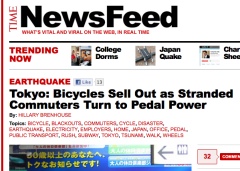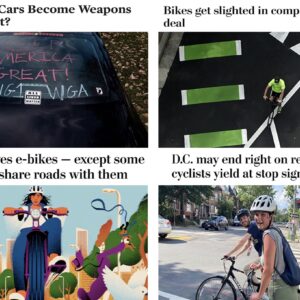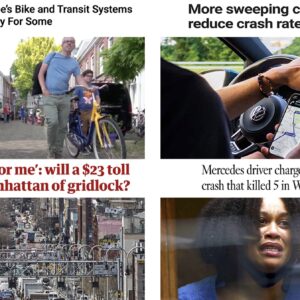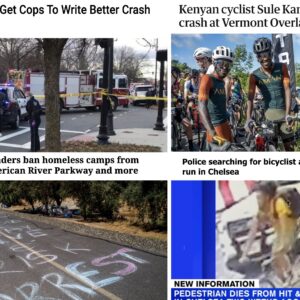
bicycles was major news.
Here’s the news that caught our eye in the last week:
– After the major earthquake in Japan, bike retailers quickly sold out their entire stock as train systems stopped running and people looked for alternatives to walking long distances home from work.
– Before the quake, a major car manufacturer had just proposed building 250,000 kilometers of bike lanes across Japan as a way to reduce collisions between people on bikes and people walking or driving.
– All journalistic hell has broken loose in the wake of a lawsuit filed by New York City’s former transportation commissioner among others who seek to have a cycle track in Brooklyn removed. Here’s a handy guide to the conversation.
– Researchers in the UK have compiled studies finding that people bicycling and walking are more likely to patronize local shops and tend to spend more money in them than people driving, whereas business owners tend to perceive that more of their customers drive to their store than actually do.
– Utah’s version of the Idaho Stop bill died in the Senate, for reasons that may sound familiar to Oregonians.
– In Detroit, bicycle infrastructure is part of the plan to entice young professionals to move to the inner city.
– Indianapolis has been quietly becoming more bicycle friendly.
– A tour of what Quito, Ecuador has to offer in terms of bicycle transportation infrastructure and culture.
– Los Angeles has a shiny, new bike plan—but when will it be built out?
– In New Mexico, outrage brews as State Police officers tell people not to bicycle in the road and decline to cite the person driving after a man on a bicycle died after being struck from behind.
– A look at some stark geographic differences in how we handle violence against people on bikes.
– An Elmhurst, Illinois street ends up with half a sidewalk after neighbors fail to agree on whether or not their street should have one at all.
– In Saskatoon, a planner wants us all to rethink the way city centers work.
– From Minneapolis, thoughts on cycling’s gender gap.
– The case for wearing black for bicycling around town.
– Combined bicycle and coffeeshops are a growing trend nationwide.
Videos of the week: Lego guys rap compellingly about their preferred alignment for Detroit’s new light rail line…
And a London program helps people who can’t pedal regular bikes use hand cycles and other assistive bicycles…




Thanks for reading.
BikePortland has served this community with independent community journalism since 2005. We rely on subscriptions from readers like you to survive. Your financial support is vital in keeping this valuable resource alive and well.
Please subscribe today to strengthen and expand our work.
I hope we never have to find out how PDX’s bridges would hold up during a similar earthquake. And if we do, I hope I’m on my bike at the time and NOT in a bus or a car.
yeah, I would also like to know when portland’s bike plan will be “built out”. of all the places I have been, portland has the fewest and most crowded bike only paths and lanes. on the positive side, there are alot of meetings about how we should be doing better and lots of people who write about those meetings!
I do love the round up, though, esp the vid about england actually helping people instead of wondering why their government won’t help people.
Are we, the bike community, going to fall for mayor Adam’s false promises again?
We will fall for those false promises, because the alternative is fearmongering and threats. Who would you rather have: a mayor who backs off from grand promises and delivers a few small parts of it; or one who doesn’t want to do anything for us and takes away a few parts of what we already have?
perhaps the latter would slap some sense into, what is IMO, a naive and apathetic citizenry. i am sick and tired of voting for the lesser of two evils (especially when “lesser evil” turns out to be anything but).
I will let spare_wheels smack down stand, I agree with him and I hate the weak compromise that you suggest. you cannot compromise yourself out of a cement truck running over you. if you can, peej, then even I would be impressed.
Something that I think falls within the scope of Monday Roundup: Reported via Twitter, the Maus family has grown by one son, born March 13th. Congratulations Jonathan and family!
Pics or it didn’t happen! Congrats Jonathan.
The bikeprovo story on the Utah’s consideration of the Idaho Stop: the writer says, “…Clearly the vast majority of the members of the legislature have little sympathy for the plight of cyclists on the roads. …”. The ‘vast’ majority? This guy must be dreaming. It was an almost even split on the bill.
I’m surprised that as many Utah legislators as did, voted for this bill. The writer points out that among the reasons some legislators objected to the proposed law, was that they felt it could bring some cyclists to become more irresponsible in following the rules of the road.
Considering that age isn’t used to limit people from riding a bike on the road in traffic, and that they’re not required to get any testing whatsoever to gauge their fitness to operate a bike on the road in traffic, that’s probably a reasonable concern. Additionally so considering the frequency that road user cyclists riding in a risky manner are using the road, and that as a result, they, falling into the category of vulnerable road users, are placing a greater than necessary burden on road users operating heavier vehicles.
Something about the bill I hadn’t picked up earlier, was that the law would allow only people 18 years and older to roll the stop signs.
i continue to not get the argument that a law that would permit you to treat a stop sign as a yield sign, and which expressly states that you cannot roll through if there is cross traffic, could possibly “encourage blah blah blah.”
‘blah-blah-blah’, is not what is suspected the Idaho Stop law would encourage. That it would further enable increasingly risky road use on the part of some cyclist road users is one of the concerns associated with the Idaho Stop.
Cyclist road users in a sense, playing the chicken game with motor vehicles on the road has been a common, ongoing area of concern expressed by many road users, whether they travel by motor vehicle or bike.
Periodically, motor vehicle operators are being asked by cycling advocates, to bear the greater burden of responsibility for avoiding cyclist/motor vehicle collisions, even though cyclists are more difficult to see than most motor vehicles.
If one of the ideas behind the Idaho Stop, is that cyclists are supposed to use the opportunity to roll through a stop sign, to get that extra little bit of margin for crossing or entering the roadway, over approaching cars traveling 40-45mph…I’ve got a feeling it’s not one that would be broadly supported.
that’s not what the proposed law says. in fact is specifically says the opposite: don’t go if it is not safe to go. also i might mention that there are thousands of intersections where the speeds on the cross street are in the 20s or 30s, and thousands where the cross street also has a stop. everyone who does not have an axe to grind knows this is a reasonable proposal.
“that’s not what the proposed law says. in fact is specifically says the opposite: don’t go if it is not safe to go. …” are
I expect you’re referring to my mention of the 40mph-45mph speed limit on some roadways, and the idea apparently held by some people, that the Idaho Stop would aid them in entering or crossing a roadway in advance of approaching traffic.
Idaho’s law, or the one Utah was proposing may not be suggesting this be done, but again, that’s apparently how some road users would be inclined to use the law. Go down a ways and check out the comment of ‘Paul in the ‘couve March 14, 2011 at 7:09 pm’.
I would have liked to have been able to hear some of the discussions between Utah legislators about why they did or didn’t think the Idaho Stop bill for their state was a reasonable proposal. (recordings available online, not really practical without a fast connection.) Even though the bill went quite a ways, it obviously didn’t carry, suggesting many of them found the proposal lacking in some way.
At least one legislator was quoted in the news as favoring the bill in part, explaining it’s too hard for some cyclists to clip in and clip out of their clipless pedals. I wonder what the other legislators thought about that selling point.
Thanks for recognizing that Utah is a pretty bicycle friendly state even though it is very conservative. Last I saw it ranked at #11 on the bike friendly states list! I hope this realization will dampen some of the perception that conservatives are anti-bike!
Agree on all counts.
By extension there is no reason to assume it is not safe for autos to coast through 4-way stop sign intersections if no other users are there. Pragmatically speaking we know this already happens, safe or not.
Is an Idaho Stop law any more safe if it only allows cyclists to safely roll through stop sign intersections?
I think part of the animosity that this law fights against is that auto drivers AND cyclists both know that they are disobeying the “letter of the law”. Even if it is perfectly safe when there are no other users no one wants somebody else to get away with something they themselves can get cited for.
thanks to the link on wearing black. includes some arguments i had not thought of. i especially liked the bottled water analogy.
From the bikingbis.com story about New Mexico State Police Lieutenant Eric Garcia’s advice to cyclists: “There’s an important message for bicyclists here. It is recommended that bicyclists visit their local bike stores for brochures and information on recommended routes of travel, instead of riding on open roadways.” Lt Eric Garcia:
“…The driver of the pickup was Larry Houck, identified by other sources as a law enforcement official at the White Sands Missile Range. …” bikingbis.com
In terms of sensitivity, Lt Garcia has something to be desired, although, the driver of the pickup seems to have got some from him.
From the article
“The goal for all cyclists on the road is to avoid cars because when cars and bikes meet, we know who loses. My goal in approaching an empty intersection is to confirm it is indeed empty with no oncoming traffic and then to get across it before any cars do show up.”
I see people come to a full stop and then impatiently and dangerously playing chicken with recklessly fast motorists all the time. Sometimes slowing down, looking both ways, and using momentum to clear a dangerous intersection is the safer option.
Yes – and even to the point where in uninformed observer may ‘intuitively’ believe you are behaving irresponsibly. When crossing a busy road with 40 to 45 mph traffic an observant rolling stop sprint across the road taking 1.8 seconds IS safer than a 4 second foot down stop and cross.
Unfortunately, the argument against that is that if one misses the opportunity for a 1.8 second sprint due to coming to a full stop, one should then wait for as long as necessary for a 4-second gap, rather than try to shoot a 2-second gap. Not that I agree with that, it’s just what you will hear from any advocate of stop-means-stop-for-everybody.
The biggest problem with passing any such law is FUD. Safe-niks Fear that cyclists who already roll stops would somehow start to do it more dangerously, and cyclists who currently stop would start dangerously rolling through. Drivers are Uncertain what a cyclist might do at any given stop, and Fear running over a cyclist who cuts it too close. They are also Uncertain how fast a cyclist may be able to get across an intersection. Only the cyclist knows his equipment, skills, and strength well enough to know whether they can “make it” in a certain amount of time. When a motorist sees a cyclist start across a street, they are plagued with Doubt about whether the cyclist will be out of the way in time. Many people Fear that cyclists are stupid and Doubt whether they will understand that a law like this does not change right-of-way rules. They Fear that cyclists will somehow believe that they have priority ROW at all intersections (and in some cases, mistakenly believe this themselves, leading to more feelings of unfairness).
You get the idea.
Doubt about whether the cyclist will be out of the way in time. Many people Fear that cyclists are stupid and Doubt whether they will understand that a law like this does not change right-of-way rules. They Fear that cyclists will somehow believe that they have priority ROW at all intersections (and in some cases, mistakenly believe this themselves, leading to more feelings of unfairness).
You get the idea.
Yes the doubt thing is a problem and of course it crops up in all kinds of places. I experienced today as I do at least 1 day out of 3 at the 4 way (7 way) stop by my house on the way to work. I came to a full stop (track stand – sorry) at the sign, and one driver decided to wave me threw even though it was her turn. Which leaves me unclear and makes the drivers at the other 5 points of the intersection unclear as to who is going. More dangerous for me than just taking her turn.
I also notice that such moments of doubt occur plenty often just between cars without bikes being involved, where the rules SHOULD be clear.
Narrator: Fly decided to speak very slowly, for it was a cold fact of nature that sheep were stupid, and there was nothing that could convince her otherwise.
Fly: Please, someone tell me… what happened this morning.
Narrator: The sheep decided to speak very slowly, for it was a cold fact of nature that wolves were ignorant, and there was nothing that could convince them otherwise.
Sheep: It was Babe… he saved us… the wolves killed Maa… But Babe drew the wolves away!
Feel free to substitute “people on bikes” and “drivers of automobiles” where appropriate.
“…Unfortunately, the argument against that is that if one misses the opportunity for a 1.8 second sprint due to coming to a full stop, one should then wait for as long as necessary for a 4-second gap, rather than try to shoot a 2-second gap. …” El Biciclero
Certain types of people are inclined to take excessive chances in whatever they do. Other people don’t particularly have the greatest sense of judgment. Stop signs exist to help counter the negative consequences of what can happen when such people are road users.
Having all road users, including excessive risk takers and those whose judgment is lacking in various ways, be obliged to stop at stop signs, encourages people and supports them in taking just a little more time to look carefully to see the way is clear before crossing or entering from one roadway to another.
Sometimes, cyclists favoring the Idaho Stop, list among their reasons for doing so, is that it saves them energy expended on having to stop, and then get started up again. It’s kind of contradictory then, to hear such a cyclist talk about sprinting through a stop sign, while not noting the extra energy expended required to sprint.
If NYC sacks Janette Sadik-Kahn can Portland get her? Pleeze? 🙂
Ah, come on… lets get to the real news…
Congrats on the New Baby Jonathan, Julie, and the Girls!
Now, when are we gonna get to meet the little guy?
Putting light rail down the middle of Woodward in Detroit instead of along storefronts is the stupid idea I’ve ever heard of.
Hart-
Care to elaborate? Or is it just because? Seems to me that it makes perfectly good sense.
The people promoting the ‘down the middle’ design are the car lovers who don’t want light rail slowing down cars, which is EXACTLY what light rail is supposed to do, in addition to getting more cars off the road.
Making peds stand unnecessarily cross this busy street just to stand in the middle of fast moving traffic is totally dangerous.
Not to mention the wasted money that could be made from keeping the platforms in front of storefronts where waiting riders could spend more time shopping.
It’s as though the ‘down the middle’ planners don’t even understand how much they’re throwing away by isolating the tracks and the riders.
I’m afraid if we did get Janette Sadik-Khan in Portland she wouldn’t last a year in Portland. Historically, our local civic politicians don’t like strong minded bureaucrats that steal their thunder or are smarter than the electeds.